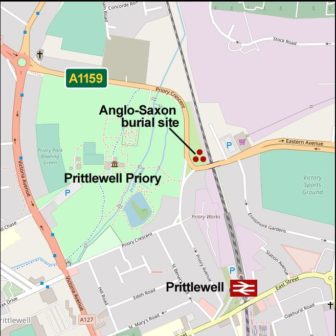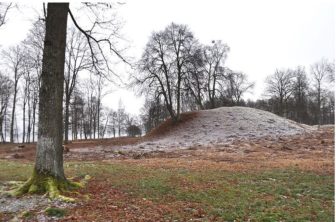Anglo-Saxon burial compared to that of King Tut
SOUTHEND-ON-SEA, England – The Guardian reported on a well-preserved Anglo-Saxon royal burial. Sophie Jackson, Museum of London Archaeology (MOLA), said it could be compared to that of Tutankhamun’s tomb, with some important differences. For the similarities, archaeologists found both tombs relatively intact. These tombs provided a glimpse into the elite material culture of both societies.

: CnbrbOpenStreetMap contributors [CC0]
Map of the Anglo-Saxon burial in Prittlewell, Southend-on-Sea Credit: CnbrbOpenStreetMap contributors [CC0
The excavations of the site began 16 years ago in 2003. Almost all organic material had decayed. One archaeologist described the tomb as a “sandpit with stains.” Based on the testing of the remains of one wooden drinking cup, the tomb chamber was assigned a date of 580 C.E.
Located north of the mouth of the Thames, the tomb chamber measured 5 feet high (1.5 m) by 13 feet wide (4 m) and by 13 feet long (4 m). As the coffin was only 5 feet 6 inches long (1.68 m), the occupant had to be shorter than that.
The burial chamber housed 40 rare artifacts. Some of these artifacts indicate that the Saxons engaged in long distance trade networks. These artifacts include a copper alloy flagon from Syria, as well as garnets from South Asia. The tomb contained the following luxury goods: a gold belt buckle, Franco-Gaulish gold coins, and a lyre with copper-alloy fittings. The chamber also contained mundane goods, such as weapons, drinking horns, cauldrons, and an ornate hanging bowl.
The luxury goods in the tomb indicate that the occupant would have had high status. Scientists think that Seax, younger brother of Seabert, king of Essex lies in this tomb.
Someone had placed gold foil crosses over the eyes of the tomb’s occupant. As Saxons converted to Christianity later than 580 C.E., the meaning of these gold crosses is not immediately clear though the archaeologists interpreted this as evidence of the occupant’s Christianity.
The alleged occupant, Seax, did have a Christian aunt so he probably was familiar with Christianity. Whether he had been baptized is unknown. Nor is the extent of his knowledge of either Christianity or Anglo-Saxon Paganism known.
These possibly Christian objects contrast with the worldly goods in the chamber. This contrast suggests a mixture of Pagan and Christian burial practices.
Museum of London Archaeology has created a website about this chamber tomb. It has an interactive visual display of tomb chamber
Ritualized cleansing of the battle-dead in northern Germania
ALEN ENGE, Denmark – The journal, Proceedings of the National Academy of Sciences (PNAS), published an article about human remains deposited in an ancient Danish lake. Archaeologists examined these remains. According to their research, those remains resulted from large battles in the first century C.E. The post-mortem treatment of the remains suggested ritualized cleansing of the battle dead.
The site has only been partially excavated. Archaeologists have found bones of 82 individuals in part of the site. Scientists have estimated that the whole site would contain the bones of, at least, 380 people. Scientists have classified 26 bones as female or probably female. They have classified another 427 bones as male or probably male.
Bone analysis revealed that less than 5% of bones belonged to people less than 20 years old. About 67% belonged to people between 20 and 40. Only about 1% belonged to people over 40. The rest of the bones (some 25%) could not be tested for age.
Most bones showed evidence of sharp and blunt force trauma just before death. All this evidence suggests that the individuals died violently in some type of battle. The bones showed no signs of healed trauma indicating minimal prior battle experience.
Weapons and other material artifacts indicate this battle occurred among Germans. At this point, Germany had a low population density. That low population density would mark the estimate of 380 total dead as a sign of a large battle.
After the conquest of Gaul in the first century B.C.E., Roman power extended to the borders of Germania. In the early part of the first century C.E., Rome began to penetrate Germania. These changes may have destabilized the German tribes and provoked intra-German conflict.
All bones show signs of animal predation. For six months to a year, the bodies likely were exposed. After this time, people likely deposited the bones in a lake. That lake contained mostly larger bones. Animal predators may have eaten smaller bones.
Relatively few skulls were found. Someone had strung a few hip bones together along a branch before depositing the arrangement in the lake.
This array of post-mortem treatments indicates that people ritually attended to battlefields. But the method and purpose remains unknown.
Ritual sacrifice of adorned guinea pigs found in Peru
TAMBO VIEJO, Peru – Archaeologists have found remains of large scale indigenous Peruvian sacrifices of guinea pigs. This finding confirms the reports of Spanish invaders about sacrifices of guinea pigs. Tampo Viejo is located in southern Peru.
Interestingly, someone had placed earrings and necklaces on these sacrificed animals. Archaeologists described the decorations as colorful. Both earrings and necklaces were made of string. Someone had wrapped a few animals in a rug.
Lidio Valdez, of the Institute of Andean Studies and Acari Valley Archaeological Project, reported on this find. In one site, Valdez and other found 72 guinea pig remains. In another, they found 28. Dating set the time of the sacrifice as 400 years ago. That would date the remains to the late 16th to early 17th Century, after the Spanish Conquest.
None of the guinea pigs had reached adulthood. Their bodies did not show any external injuries. Scientists believe that the sacrifice involved asphyxiation. These animals may have been buried alive. Someone had placed their bodies underneath buildings with their heads facing up.
While the Spanish reported sacrifices of guinea pigs, they had never mentioned adornment. This excavation marks the first discovery of adorned sacrificed guinea pigs.
Land-burial of a Viking ship
BORRE, Norway – Borre Park in Norway contains a large collection of Viking monumental grave mounds. These mounds date from the Iron Age. Other Viking ship burials are located there. All evidence points to Borre Park as a major power center in the pre-Viking and the Viking Ages. That park is located in southeastern Norway, about 100 miles south of Oslo.

Helen Simonsson [CC BY-SA 4.0 (https://creativecommons.org/licenses/by-sa/4.0)]
Burial Mound in Borre Mound Cemetery – Image credit: Helen Simonsson
Recently, ground penetrating radar identified another land-burial of a Viking ship in this park. The site had a circular depression, suggesting that at some time, a mound likely covered it. That mound has since disappeared. Archaeologists will use non-invasive techniques to examine this new find in Borre Park. They do not plan to excavate.
Only seven ship burials from the Viking Age (800-1050 C.E.) have been found. Three of them are in Vestfold County, the site of Borre Park. Only high status individuals would be buried in a ship. Decorative goods, and sometimes oxen or horses would be buried with those high status people. Sometimes Viking burials included human sacrifices. The buried ship would then be covered by a mound of dirt.
The Wild Hunt is not responsible for links to external content.
To join a conversation on this post:
Visit our The Wild Hunt subreddit! Point your favorite browser to https://www.reddit.com/r/The_Wild_Hunt_News/, then click “JOIN”. Make sure to click the bell, too, to be notified of new articles posted to our subreddit.
